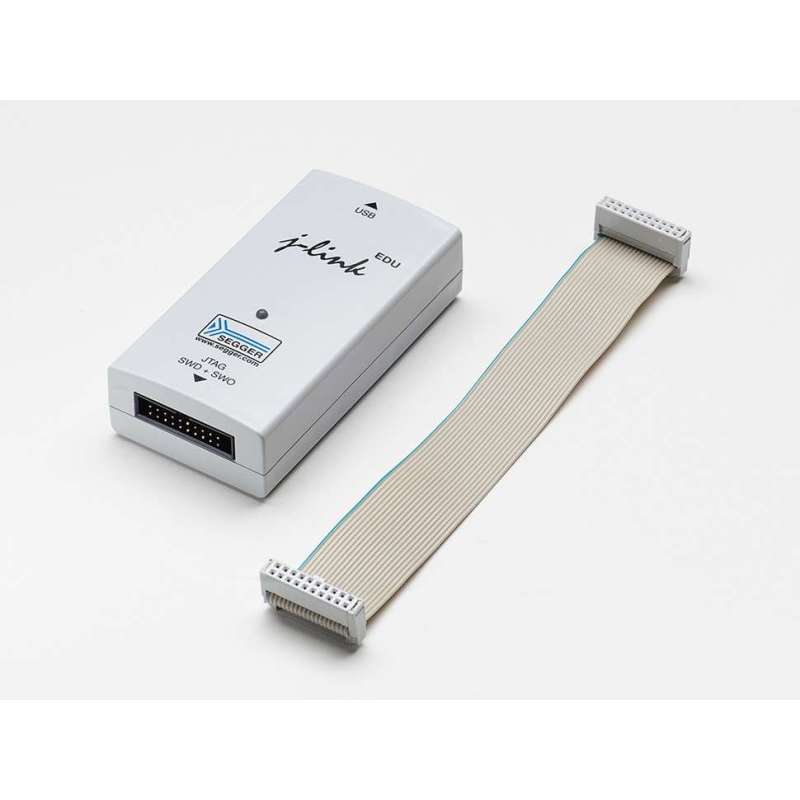



RLX COMPONENTS s.r.o. , Electronic Components Distributor.
RLX COMPONENTS s.r.o. , Electronic Components Distributor.
SEGGER J-Link EDU - JTAG/SWD Debugger (Adafruit 1369)
8.08.90 J-LINK EDU
Doing some serious development on any ARM-based platform, and tired of 'printf' plus an LED to debug?
A proper JTAG/SWD HW debugger can make debugging more of a pleasure and less of a pain. It allows you to program your devices at the click of a button, read or write memory addresses or registers on a live system, temporarily halt program execution at a given location or condition, and much more. Essentially, it's a direct window into what's going on inside your MCU at any given moment, giving you a level of access and control that's not easy to replicate with other debugging methods.
Of the dozens (and dozens!) of debuggers out there (we have literally drawers full of them!), we chose the J-Link for a number of reasons:
The J-Link is fast. Stepping through breakpoints and reading memory addresses is quick, as is programming the flash memory on the chips. It's real strength, though, is that it's so vendor and tool neutral. Most chip vendors today provde low cost (or free) tools, but they also lock you into their chips and force you to accept the choice they've made for you. Segger's J-Link is a nice change in that respect, since you can be reasonably certain it will work with any chip, in any major toolchain, and you're free to change camp (or OS or IDE) without having to buy a new debugger every time.
Why Would I Want This?
You can do a lot of basic debugging with just printf and an LED, and you may not need a HW debugger to get started, but once you start to working on more complicated projects, you hit a debugging wall pretty quickly.
Your chip might be ending up in the HardFault handler, for example, but without a debugger it can be very hard to trace back exactly what is causing the problems. A debugger allows you to set 'breakpoints' in your code, where execution will temporarily stop, and you can check the value of memory or peripherals at that point in time, and then 'single-step' through your code line by line, executing your program until you find the place that causes your fault. There's a lot more to debugging than simple breakpoints, but you can often solve in a few minutes with breakpoints what would take much longer with printf and instrusive blocking mechanisms you insert into your code without a debugger.
Whether you're using GDB Server (GNU Tools) or an IDE and a commercial toolchain, it's also just a big convenience, since the J-Link can program the flash for you at the click of a button, reset the device, start execution, and then 'halt' on main(). You can do all these steps yourself -- programming the device via free tools over UART or via a USB bootloader, etc. -- but when you need to do that 40-50 times a day, it can get old quick, and 15 seconds saved make a huge difference when debugging. You can program a small MCU and break on main in 2-3 seconds with a J-Link, which makes the tools more or less invisible, which is a good thing when you have other problems to worry about.
What is the J-Link EDU?
The J-Link usually sells for a few hundred dollars up to four figures, but Segger makes a special, low-cost 'EDU' version of ther J-Link available. It's feature complete (including GDB Server support, unlimited flash breakpoints, etc.) and the same debugger you'd buy for professional use, but it has the following limitations (source: http://www.segger.com/j-link-edu.html):
You may use the J-Link EDU for non profit educational purposes only! Non-profit educational purposes means that you may not use the J-Link EDU and its J-Link software
What does this mean? Basically, if you're making money (or plan to make money) off your project, you'll need to order the full commercial version, or find a different debugger that suits your needs and budget better. But if you're working on personal, non-commercial projects, such as publishing some open source designs you're not selling yourself, you're good. You don't need to be a student, and you can even be a paid engineer during the week, using this on the weekend for personal non-commercial projects. As long are your intentions are non-commercial, the J-Link EDU is an excellent choice!
SEGGER J-Link EDU - JTAG/SWD Debugger (2:47)
User guide